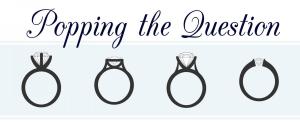When it’s time to get down on one knee, throw out everything you think you know about nerves. Aside from the time and the place, your proposal has to contain all the perfect elements that’ll help your significant other say yes. Whatever your budget or your situation, one of the most important parts of any engagement is the ring.
The perfect engagement ring will vary from couple to couple. For instance, few partners in a couple that is struggling for money will appreciate an expensive rock that gets them into debt. No partner in a wealthier couple that has plenty of money to spend will thank you for a cheapskate ring, either.
Instead, picking the right ring is a combination of factors. From the affordability to the design, lots of little details can help push him or her in the direction of that all-important ‘yes.’ Luckily, Lycetts, who are experts in engagement ring insurance, have created this guide to buying the ideal ring:
How much should you pay?
This is the first question on everyone’s mind when you’re thinking about buying a ring. Thanks to years of marketing and the value of precious stones, an engagement ring is likely a daunting financial purchase. However – one simple rule has emerged: don’t put yourself into debt to buy a ring. Instead, spend as much as you can to get something fabulous without truly breaking the bank.
The age old rule of three month’s salary is long dead, as you can get an eye-catching ring affordably. One thing to bear in mind is that your partner is going to wear the ring for the rest of their life – so make sure it’s something special.
Which material should you choose?
There are a few popular band materials to choose from, as well as some unusual versions:
• Gold: Gold is the classic style and comes in various carats which indicate its purity. This is between 9, 14, 18, 22 and 24 carats. 22 is the purest form for jewellery.
• Silver: Silver can be prone to tarnishing, but is a precious metal that turns heads for a reason and truly makes gems shine.
• Platinum: Platinum is arguably the best choice for a wedding band as its hard-wearing, durable and hypoallergenic. It’s the most expensive material due to its quality.
• Palladium: A softer and more affordable alternative to platinum.
• White Gold: White gold follows the same principles as gold, but is alloyed with precious white metals like silver or palladium to give it a beautiful, eye-catching polish and shine. The coating makes this a more expensive alternative to gold.
Choosing a setting
You’ll have to decide on a setting, which refers to how the stone sits on the ring.
• Prong: This means a set of prongs that grip the diamond or stone in place. They allow plenty of light into the stone, but can sometimes snap, making engagement ring insurance vital.
o The Cathedral: This is a variant of a prong setting that pushes the diamond even higher on the ring.
• Tiffany: This is a trademarked six-prong style.
• Bezel: The bezel setting offers a modern look, with diamonds set into a bezel. Due to its sturdiness, it’s good for people who do active professions.
• Tension: This is when the ring holds the diamond in place with tension, giving the appearance of the gemstone floating between the metal.
• Channel: This is when you set diamonds into the ‘channel’ of the band, often tightly together.
• Pavé: From the French word ‘to pave’ this setting refers to a ring ‘paved’ with diamonds that have tiny beads or prongs holding them in place.
• Halo: Refers to small diamonds set in a circular pattern that repeats across the surface to create the ‘halo.’
There are other settings available – but those listed above are the most popular.
The final step: choosing a stone
The most important aspect of any engagement ring is the stone that adorns it. Diamonds are a girl’s best friend for a reason: they offer incredible shininess and clarity. However, you’ll need to decide on the clarity, carat, colour and shape.
Unlike gold, the carat of a diamond refers to the weight not the purity. Generally, ring diamonds are between 0.1 to full 1 carat stones – but as a luxury purchase they can rise in size up to 100 carats. These rings, however, are worth millions. The diameter of a stone is different to the weight, and therefore a careful buyer can get a larger ring by buying a lesser weight with a larger surface area.
You’ll also need to choose clarity and colour. Pick the best clarity you can afford – but colour isn’t as important as only expert jewellers can usually spot any difference. The band material typically gives the diamond some of its colour anyway.
Picking a shape
Diamonds come in many different shapes, which affect the overall look of the ring.
• Round: The most popular shape, this simple style makes up 75% of all diamonds sold. It is reflective and maximises brightness as a result.
• Princess cut: A fancy shape designed for elegance.
• Oval: An elongated shape which makes the stone appear larger.
• Marquise: A football-shaped, brilliant-cut diamond which has the largest surface area of any stone.
• Pear: Pear-shaped diamonds combine marquise and round shapes.
• Cushion: A cushion diamond is a square cut with folded corners.
• Emerald cut: A large, flat-faced diamond with a hall of mirrors aesthetic.
• Radiant cut: Similar to an emerald cut, but offering a vibrant face.
• Heart-shaped: The iconic symbol of love.
After you’ve selected your ring, all that’s left is sneaking around to try and discover their size. Oh, and popping the question! However you choose to propose, we’ll leave the rest up to you!


Add new comment